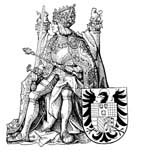
Understanding the All-Male Priesthood
THE INTEGRATED WISDOM OF CATHOLIC SEXUAL TEACHING
To the modern liberal mind, Catholicism is a puzzle, and an annoying one. Consider the television show titled “John Paul II: The Millennial Pope,” which aired in fall 1999 on Frontline on PBS. With the help of a number of talking heads who are dissenting Catholics or former Catholics, the show sought to expose the Pope as a man of contradictions. Why did he support Solidarity and the workers in Poland — but not liberation theology in the Americas? Why does he work so hard to cultivate relations with the Jews — when it’s presumed that anti-Semitism is built into Christianity? Most puzzling of all are the presumed contradictions in his attitude toward women: How can he claim to venerate Mary — and yet bar women from the priesthood?
Frontline proposed that the key to John Paul’s “contradictions” lies in his tortured psyche. Why does he want good relations with Jews? He feels guilty about the Holocaust. Why is he so pro-Solidarity but anti-liberation theology? He’s a Polish nationalist but despises and fears the West. What accounts for his position on women? His mother’s death left him emotionally scarred. The implication for the question of the role of women in the Church is clear: We are meant to conclude that the Pope is imposing his private neurosis on a Church ready to move ahead with priestesses.
The attempt to psychologize him is symptomatic, for the Pope is a philosopher, and we live in an age in which psychology has usurped the place of philosophy. Philosophy seeks to understand man in relation to the whole; psychology seeks only to know man in relation to himself. We’ve given up aspiring to know objective truth; we aspire rather to “get in touch” with our “selves.” And so the question of women’s ordination is made simple for liberal opinion: A woman who “feels” that she is called to the priesthood is deemed a better judge of the matter than is the Church and the Pope. But such opinion is no part of the Catholic faith, of which the Pope is a loyal guardian. For Catholicism is a faith that contains the whole (katholikos is Greek for “containing the whole”). Seeing no whole, even denying the possibility of a whole, pundits outside the Church and special-interest dissenters within the Church cannot appreciate what Catholicism is all about. If we really want to understand John Paul’s teaching on the male priesthood, we must look not to his personal background but to Catholic theology — particularly to the perennial Catholic teaching on human sexuality, for it is within this context that the male priesthood can be understood.
We are living in the wake of a revolution which transformed the once sacred precincts of human sexuality into a secular playground, a place of recreation, experimentation, and personal convenience. Our culture often extolls sexual license, and promotes androgyny — a bland blending and neutering intended to eradicate the differences between the sexes. Our culture welcomes the “liberating” notions of priestesses, same-sex “marriage,” and sex without consequences. But all these are patently incompatible with Catholic teaching on sexuality, which like a gold chain contains a number of links distinct but interconnected, and is rendered strong through that interconnection. The reservation of the priesthood to males is a link in this chain, as important and crucial as any other, and it cannot be removed without shattering the whole.
You May Also Enjoy
Could the Catholic Church end up sliding down the same slippery slope as the Anglican Communion? Yes, if certain groups get their way.
No temporal or civilizational events can override the sacramental necessity of the Catholic priesthood’s being reserved to men.
Aboard a tour boat, a group of sandal-clad, middle-aged women thought they were being "ordained" into the Holy Roman Catholic priesthood.

